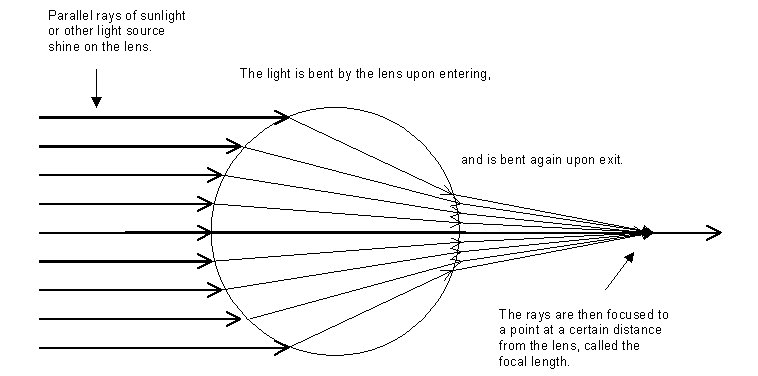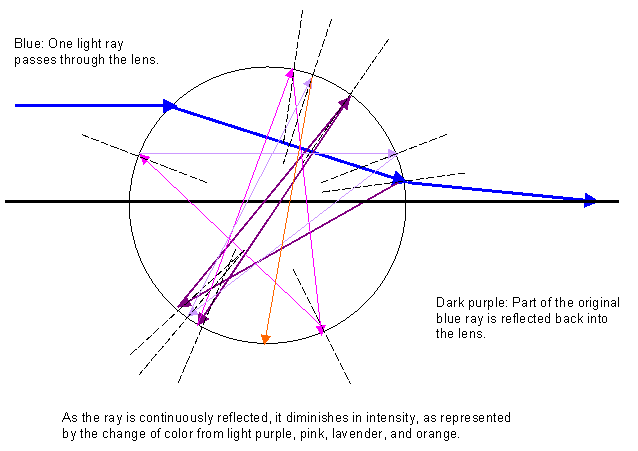
The Optics of a Spherical Dew Drop
Background
The spherical dew drop forms on hairy leaves and other tiny, spiked surfaces as dew condenses in the early morning. When sunlight shines on a dew drop, one or several bright spots can be seen on its surface when viewing at different angles. The goal is to determine how these bright spots form, and what governs the number that appear.
A model of a spherical dew drop is a water sphere lens, which is a glass sphere filled with water. Because water has a different refractive index than air, light is bent upon passing through a dew drop. In the case of the water sphere lens, there is glass surrounding the water, and its different refractive index will cause light to bend in a slightly different pattern than if the glass was not present. This effect was ignored because in nature, the surface of a dewdrop is not 100% water. Although dust particles may adhere to the drop's surface, bright spots still form. If the surface's refractive index is not changed significantly, then the pattern of bright spot formation on the dew drop should not change. In the case of the water sphere, the refractive index of glass is 1.52 (typical crown glass), and the refractive index of water is 1.33. There is only a 12.5% difference between the refractive indices, so it was decided to ignore the light-bending effects of glass, at least initially.
The sphere acts like a thick, concave lens, causing sunlight to converge at a point opposite the direction of the sun. Since the sun is very far from the sphere, the rays of light hitting the surface of the sphere are essentially parallel, and light rays bend upon passing through the sphere as shown below.

The change in speed that occurs when light passes from air to water is responsible for the bending of light, or refraction, that takes place at an air-water interface.
Light rays bend upon entering the sphere, and bend upon exit. The angle at which the rays bend are dependent upon their angle of entry (angle of incidence) and the refractive indices of the two media (air and water) that the light is passing through.
If angles are measured from a perpendicular line to the normal to the interface, the angle of transmission of the light into the second medium is related to the angle of incidence by
Snell's Law.
The problem
Looking at the diagram above, it appears that all parallel rays of sunlight become focused to one point outside of the lens. If the dew drop focuses light to just one point, then how can multiple bright spots form? Also, if the dew drop focuses light to a point outside of itself, then how can bright spots form on its surface? There is something occurring within the dew drop that has not been dealt with yet.
The first answer
There are two things that should explain why these multiple bright spots form. The first deals with a property of water, and the second deals with how a spherical dew drop forms. First, although water appears transparent, it does reflect a small bit of light. Therefore, as sunlight passes through the water sphere lens, not all of it becomes focused to a point at the other end. Some of that light is reflected by the water. As this reflected light gets ready to pass through the sphere again, most of it escapes, but some of it is reflected once more. When light is reflected from a surface, the angle of reflection is equal to the angle of incidence. This is shown below with the dotted lines; the dotted lines are perpendicular (normal) to the surface of the sphere. The incident ray and the reflected ray both make the same angle with their respective dotted line.

Everytime an arrow points toward the outside of the lens in the above diagram, light is escaping from the sphere. If standing at an angle so that the front tip of each arrow can be seen, then light will be seen coming from the sphere in that direction. Since more than one light ray enters the sphere, forming a multitude of reflections similar to that shown above, light should be transmitted through the sphere in all directions. This does happen; when looking at the sphere from different angles, enlarged and spherically distorted images of the surroundings in the direction of the light source can be seen. More importantly, bright spots are seen, and these spots change position according to the angle of view.
The second answer
The second way of looking at how bright spots may form on spherical dew drops is to examine how these dew drops form. Spherical dew drops form on tiny prominent surfaces such as plant hairs. This means that the dew drop is not entirely composed of water; a small part of the inside of the dew drop is made up of the substrate on which the dewdrop formed. This surface may be either absorptive or reflective of light, and because of the presence of this surface, reflection patterns in the dewdrop may change.